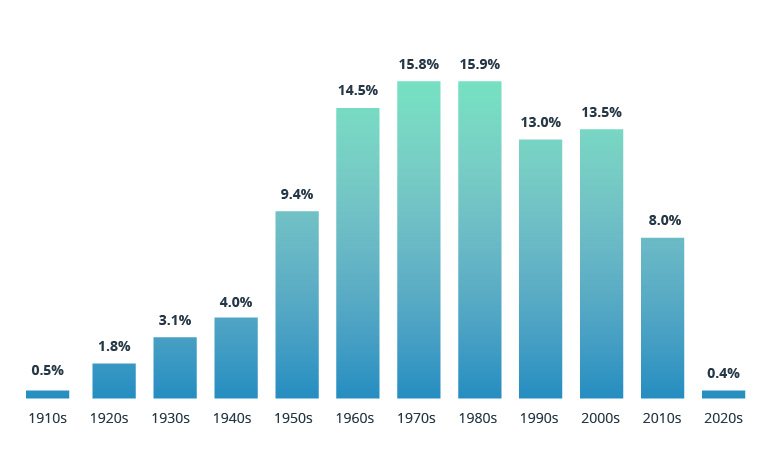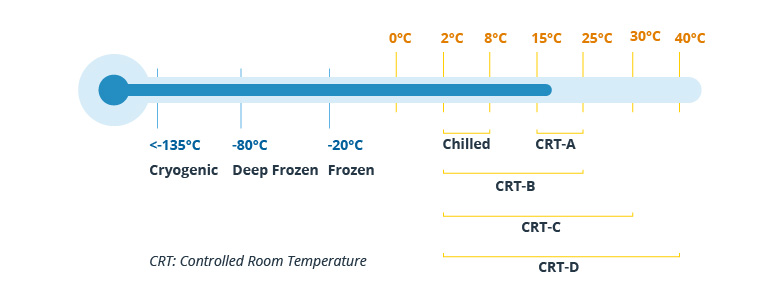From farm to table is an attractive value proposition for consumers. But it’s operationally challenging for manufacturers. Transportation of temperature-sensitive shipments has become a tough business: you need a lot of patience to ensure that goods are transported in the right condition at every step of the supply chain, be it by truck, aircraft, or a medical trolley.
What is cold chain logistics?
The cold chain logistics industry is a combination of science, technology, and business processes aimed at determining the best way to transport perishable goods.
Pharmaceuticals, fresh produce, and frozen products require special conditions for transportation. Failure to provide these conditions risks spoilage, recalls, and other risks to end consumers.
Moving such products (and their components) through the global supply chain, which stretches over multiple checkpoints at different locations, is the task of many agents:
- Cold storage and cooling system providers
- Cold transport managers
- Sea and airport workers
- On-site cold processing and distribution agents
- Logistics companies in charge of delivering the entrusted goods
Back in the old days, a block of ice and a quick prayer were all that businesses had to transport perishables.
In the twenty-first century, we have more advanced cold chain technology — IoT sensors, location-based services, cloud computing, and predictive analytics, among other novelties. This host of technologies is used to provide a precise temperature-controlled environment during the entire cycle of intermodal transportation.
Still, cold chain logistics isn’t an easy sphere in which to operate. Every leg of transportation remains dependent on manual labor:
- Cold storage containers need to be plugged in and unplugged at warehouses.
- The temperature inside containers has to be checked regularly.
- On-the-ground staff need to react fast when a new shipment arrives.
- Visibility and traceability throughout the full cycle is crucial.
Inevitably, mistakes and mishandling happen. Perishable products either go to waste (meaning lost profits) or worse — get publicly recalled from the shelves (meaning damaged brand reputations and regulatory interventions).
In 2019, US Food Safety and Inspection Service recalled over 20 million pounds of food produce.
Regulators keep close tabs on how perishable products travel through the supply chain and introduce new controls. In 2017, EU regulators issued Good Distribution Practices that introduced stricter rules for transporting temperature-sensitive pharmaceutical products. The WHO also imposed non-negotiable transportation guidelines for pharmaceutical companies.
In response, the demand for cold chain logistics solutions and refrigerated warehouses shot up. But the lack of process standardization, limited visibility, and high operational costs prevent a lot of companies from scaling their cold logistics.
Why cold chain logistics is a hot issue
In 2021, the pharmaceuticals, consumer packaged goods, and agricultural industries are driving the demand for cold chain logistics solutions.
By 2026, the cold chain logistics market will hit $58.51 billion, growing at a CAGR of 17.9%.
There are good reasons for the upsurge in demand:
- Increase in temperature-sensitive biological shipments. In 2019, cold chain logistics already accounted for 26% of shipments in the pharmaceuticals market. In 2020, 27 of the 50 top-selling drugs required cold chain storage and transportation at 2 degrees to 8 degrees Celsius. With COVID-19 vaccine distribution underway in 2021, it’s safe to assume that the demand will keep rising.
- Frozen goods are a new favorite among consumers. In the US alone, retail sales of frozen goods netted $65.1 billion last year. Over 57% of consumers admitted that they started buying more frozen foods since the start of the pandemic to “prep” and stockpile.
- The online grocery market is booming. In 2020, the US accounted for almost 29% ($198 billion) of the global online grocery market. China, Japan, Canada, and Germany are the other markets projected to experience double-digit growth in the online grocery market between 2020 and 2027. The total EU market for online grocery shopping is expected to reach $110 billion by 2027.
- The dairy trade remains strong. Prices for dairy products rose by 1.7% globally in November 2019 alone. Despite ongoing trade tensions and tariff wars between major suppliers — the US, Europe, and China — export volumes keep growing. The recent US–Japan trade deal for cheese exports and the USMCA agreement further open doors for cross-border dairy shipments.
The demand for cold chain solutions is strong. But what stands in the way of execution?
Pervasive issues affecting cold chain logistics management
Despite the high demand, only a handful of logistics companies can step up to the challenge of providing temperature-controlled shipments of vaccines and other highly regulated pharmaceuticals.
In the US, 78% of cold storage warehouses are two decades old and are no longer suited for modern operational requirements.
Percentage of total US cold storage warehouses inventory built in a given decade

Source: JIL — Cold storage in the post-COVID economy.
At the same time, the online grocery and meal kit delivery markets alone are projected to demand an extra 100 million square feet of cold storage warehousing space over the next five years.
However, cold logistics operations aren’t just restricted by real estate. New solutions for digital cold chain monitoring, management, and optimization are in high demand too. The industry needs to overcome the following issues:
- Fleet management inefficiencies. Refrigerator units and trucks often malfunction. Ordering spare parts and maintenance can bottleneck operations. At the same time, lack of cold chain visibility into fleet movements can result in shipment delays and scenarios when imported products sit too long at ports of entry (often in subpar conditions).
- The high cost of marginal temperature errors. Transporting products requiring precise temperature and humidity conditions is an expensive endeavor. But with limited visibility and control, companies carry major losses if there’s a slight change in the transport environment. The stakes are particularly steep for high-value pharmaceutical products.
- Lack of remote control of refrigerated vehicles, cooling systems, and containers. Even if monitoring is in place, making any adjustments to transport conditions remotely and in real time is nearly impossible. Marginal errors are often left unattended until the product arrives at the next checkpoint.
- Low precision in manual handling. Even when there’s a human worker in sight to make adjustments, not everyone has the knowledge, skills, or equipment to effectively handle sensitive shipments.
- Missing controls during transit. After handing over the product, manufacturers have little to no control over how it’s going to be packaged and stored in the hold of the aircraft or vessel. Proper positioning can be crucial for certain product types. But the means to control that positioning are mostly absent.
Cold chain technology services offer a rapid response to common shipment perils
Similar to the wider transformation of the supply chain industry, cold chain logistics is undergoing digitization too.
The aforementioned inefficiencies are prompting leaders to investigate better approaches to ensure:
- Proper packaging
 Source: DHL — The Smarter Cold ChainThe problem with traditional temperature sensors (installed in refrigerated trucks and containers) is that they are challenging to monitor remotely.
Source: DHL — The Smarter Cold ChainThe problem with traditional temperature sensors (installed in refrigerated trucks and containers) is that they are challenging to monitor remotely.
IoT devices are more versatile. They can be programmed to capture a wider range of data points such as:
- Temperature
- Humidity
- Position
- Pressure
- Visual state of the product
Such devices are also more mobile, meaning they can be attached to individual containers for more precise monitoring; plus, they can stream data in real time so that you can effectively track and trace any tagged object.
Whenever sensors detect a change in the environment, they can automatically alert the shipper, on-the-ground personnel, and the supply chain management team on-site to make prompt corrections. Or they can automatically adjust the surrounding environment based on predefined parameters.
IoT connectivity can also help determine if a product has been tampered with (for example, by a careless forwarder) and better document all transportation conditions:
- Where the product has been
- Who had contact with it
- Which processes it has been exposed to
- Which potentially dangerous actions happened
Such insights could help manufacturers establish better accountability at different stages of the cold supply chain, allowing them to reduce the chances of compromised shipments, mishandling, and other leaks.
Geofencing powered by location-based services
Location-based services — software that uses geodata to provide extra context — can improve existing cold chain visibility solutions.
By capturing GIS and GPS data, you can track your fleet movements in real time and receive updates when the main milestones of your product’s journey are reached (e.g. when shipment x arrives at port Z). Such an automated alert system, paired with sensor data, can help automate compliance and product quality reporting.
Also, location-based services facilitate the implementation of geofencing — a digital, dynamic set of boundaries you can set to monitor all actions inside the geofenced area.
For example, when a shipment enters a geofenced zone, your team can immediately get notified so they can prepare the necessary equipment for rapidly processing the temperature-sensitive delivery. Such a heads-up helps improve shipment scheduling, dock preparations, and on-the-ground staff efficiency.
You can also set geofences for a set of truck routes to get notified whenever a truck deviates from the planned route or experiences a delay due to unexpected weather conditions, heavy traffic, or a breakdown.
96% of fleet managers using GPS fleet tracking software found it beneficial. Among them, 32% reported a positive ROI in 6 months after implementation.
Here’s what’s possible with new-generation fleet management software:
A temperature-sensitive shipment is due to arrive in 30 minutes as per an automatic alert. When the truck enters the geofenced warehousing area, it automatically transmits all the shipment details including product volume, current temperature, humidity levels, and any special handling instructions.
The driver receives directions towards the correct dock, while the personnel on the ground are alerted to prepare the unloading area.
Integrated risk management and cost optimization
Cold chain logistics processes are bound by internal SOPs and external global regulations. Ensuring consistency in adherence to these across the entire supply chain is a tough act to master. Inconsistent execution increases logistics risks and magnifies the costs of cold shipments.
That’s why leaders in the cold chain logistics space are increasingly digitizing their supply chain operations and aiming to integrate a wider range of data from other business systems (e.g. ERPs) and business partners (e.g. third-party logistics companies, or 3PLs).
Greater connectivity results in improved cold chain visibility and control for both logistics companies and manufacturers. By integrating 3PLs into their operations, manufacturers can set up mutually beneficial SOPs and service-level agreements (SLAs) for shipments, plus develop risk assessment engines powered by the joint data of the involved parties.
Through such tight collaboration, both logistics companies and manufacturers can reduce the risks at different stages of delivery and run joint processes without any constraints. Such a setup is made possible by cloud technologies and API connectivity — a standard for connecting different applications to securely exchange data.
By joining forces and consolidating data, shippers and manufacturers gain a wider view into the cost-tanking links of the supply chain so they can better understand, anticipate, and manage the direct and indirect costs of cold chain logistics:

Source: DHL — The Smarter Cold Chain
Data consolidation, improved data management practices, process standardization, and better coordination can help logistics providers locate indirect costs and proactively manage them.
For example:
- Management time can be decreased with better transportation logistics software solutions.
- Product losses can be recouped with IoT-powered controls over transportation conditions.
- Invoicing and back-office processes can be accelerated via ERP system extensions and integrations with more data sources and automation tools such as robotic process automation (RPA).
The hot take on the cold chain
The cold chain logistics industry is undergoing major growth. But without integrated and consolidated solutions, it’s bound for a slow and inefficient expansion.
Three technologies can drive scorching hot improvements for cold chain management:
- Smart hardware. IoT systems for real-time monitoring of shipments, trucks, and other moveable assets can boost visibility.
- Location-based services. Geofencing capabilities and GPS data can help monitor shipments en route and prevent delays.
- Cloud-based management interfaces. Extend your current solutions with extra capabilities and data sources to get an aggregated, real-time view of your operations.
With these three cold chain technology services, any cold chain player will be well-positioned to capitalize on the emerging market opportunities.
Contact Intellias to discuss how this hot triumvirate of emerging tech solutions can benefit your business!

 Source: DHL —
Source: DHL — 


